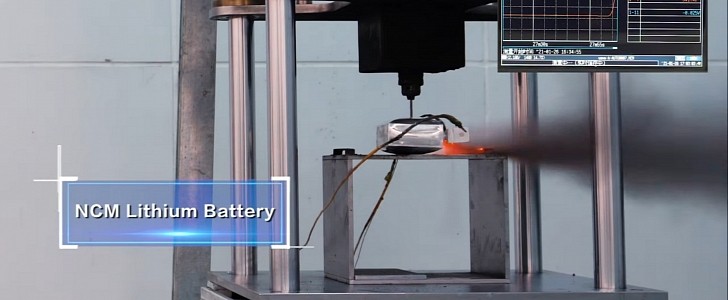Anyone who follows battery technology for electric cars knows by heart the advantages of ternary cells over LFP (lithium iron phosphate) and vice-versa. However, a nail penetration test and its effects on both types of batteries are way more convincing than just the theoretical discussion around it, as the video below shows.
BYD developed a solution with LFP cells that it calls Blade Battery. It makes the cells work as structural components thanks to the CTP (cell-to-pack) approach. The nail penetration test is a courtesy of the Chinese automaker trying to demonstrate how safe its batteries are.
The first test is performed with what looks like a prismatic NMC cell. As soon as the nail invades the battery case, fumes start to escape from it, and an explosion happens. The graphics on the video show that the voltage drops to zero after only three seconds and that the temperature jumps from around 22ºC to a peak of 961ºC (1,112ºF). What follows is a fire that slowly fades away.
The experiment reproduces a thermal runaway. This short circuit happens inside ternary cells due to dendrites – metal spikes that put the anode and the cathode in direct contact – or manufacturing defects such as the two that affected LGES (LG Energy Solution) batteries in the Hyundai Kona Electric and the Chevrolet Bolt EV. In a way, what you can see in the video must be similar to what happens in battery packs that catch fire spontaneously.
When the test puts a nail through an LFP cell, there is just a tiny voltage drop (0.03V) in five minutes, and the temperature also increases. The difference is that it goes from around 22ºC to only 60ºC (140ºF). We only know that thanks to the video subtitles: it is not long enough for us to see what happens to the LFP cells after five minutes.
Although the LFP cell literally nails this test, BYD is yet to provide an explanation for the fire that happened with a Han sedan 48 hours after a crash test. According to the company, it would have been caused by the wrong coolant, not the one it claims to use on vehicles with a Blade Battery.
Considering the guys that did the crash test said the coolant was the same BYD put in the car in the factory, that’s the explanation we are still waiting for. If it was not caused by any issue with the Blade Battery, the nail test might prove that LFP cells offer more peace of mind for early EV adopters. BYD may help more people get them when it starts selling the Dolphin in countries other than China.
The first test is performed with what looks like a prismatic NMC cell. As soon as the nail invades the battery case, fumes start to escape from it, and an explosion happens. The graphics on the video show that the voltage drops to zero after only three seconds and that the temperature jumps from around 22ºC to a peak of 961ºC (1,112ºF). What follows is a fire that slowly fades away.
The experiment reproduces a thermal runaway. This short circuit happens inside ternary cells due to dendrites – metal spikes that put the anode and the cathode in direct contact – or manufacturing defects such as the two that affected LGES (LG Energy Solution) batteries in the Hyundai Kona Electric and the Chevrolet Bolt EV. In a way, what you can see in the video must be similar to what happens in battery packs that catch fire spontaneously.
When the test puts a nail through an LFP cell, there is just a tiny voltage drop (0.03V) in five minutes, and the temperature also increases. The difference is that it goes from around 22ºC to only 60ºC (140ºF). We only know that thanks to the video subtitles: it is not long enough for us to see what happens to the LFP cells after five minutes.
Although the LFP cell literally nails this test, BYD is yet to provide an explanation for the fire that happened with a Han sedan 48 hours after a crash test. According to the company, it would have been caused by the wrong coolant, not the one it claims to use on vehicles with a Blade Battery.
Considering the guys that did the crash test said the coolant was the same BYD put in the car in the factory, that’s the explanation we are still waiting for. If it was not caused by any issue with the Blade Battery, the nail test might prove that LFP cells offer more peace of mind for early EV adopters. BYD may help more people get them when it starts selling the Dolphin in countries other than China.









